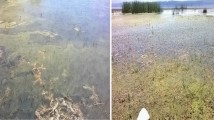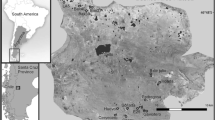Abstract
From December 2009 to December 2010, the total abundance of bacteria, the abundance of bacteria with electron transport chain, the abundance of viable saprotrophic bacteria, and the concentration of chlorophyll a were studied in water samples from lakes Svyatoe, Beloe, and Chernoe in Kosino-Ukhtomskoe district, Moscow City. The abundance of bacteria with active electron transport chain (CTC+bacteria) and its seasonal variations in Kosinskie Lakes are studied for the first time. Those lakes were found to contain well-developed and actively functioning heterotrophic bacterioplankton, the abundance of which have increased considerably since the 1930s–1940s. The seasonal dynamics of bacterioplankton has also changed. The largest absolute abundance of CTC+bacteria in lakes Svyatoe and Beloe was recorded in summer and autumn (from August to November). The abundance peak of CTH+bacteria in Lake Svyatoe was recorded in September and that in Lake Beloe, in October. The abundance of CTC+bacteria also showed a peak in April. In Lake Chernoe, the abundance of CTC+bacteria was much less than in lakes Svyatoe and Beloe; its maximums were recorded in December 2009 and April 2010. The share of CTC+bacteria in the total abundance of bacteria was 2.4–19.2% in Lake Svyatoe, 1.8–63.0% in Lake Beloe, and 0.96–22.5% in Lake Chernoe. Significant correlations were found to exist in all three lakes between the abundance of active bacterioplankton fraction and chlorophyll a content of water.
Similar content being viewed by others
References
Bul’on, V.V., Regularities in the primary production in limnic ecosystems, in Tr. Zool. Inst. (Proc. Limnol. Inst.), St. Petersburg: Nauka, 1994, vol. 216.
Vagner, B.B., and Dmitrieva, V.T., Ozera i vodokhranilishcha moskovskogo regiona. Uchebnoe posobie po kursu “Geografiya i ekologiya Moskovskogo regiona” (Lakes and Reservoirs of the Moscow Region. Textbook on the Course “Gerography and Ecology of Moscow Region”), Moscow: MGPU, 2004.
Il’inskii, V.V., Heterotrophic bacterioplankton, Prakticheskaya gidrobiologiya: Ucheb. dlya stud. biol. spets. universitetov (Practical Hydrobiology: Textbook for University Students in Biology), Fedorov, V.D., Kapkov, V.I., Eds., Moscow: PIM, 2006, pp. 331–365.
Karzinkin, G.S., and Kuznetsov, S.I., New methods in limnology, Tr. Limnol. st. v Kosine, 1931, no. 13–14.
Kitaev, N.P., Ekologicheskie osnovy bioproduktivnosti ozer raznykh prirodnykh zon (Ecological Fundamentals of Bioproduction in Lakes in Different Natural Zones), Moscow: Nauka, 1984.
Kopylov, A.I., and Kosolapov, D.B., Bakterioplankton vodokhranilishch Verkhnei i Srednei Volgi (Bacterioplankton of Reservoirs in the Upper and Middle Volga), Moscow: Izd. SGU, 2008.
Kuznetsov, S.I., Microbiological studies in examining oxygen regime of lakes, Mikrobiologiya, 1934, vol. 3, no. 4.
Kuznetsov, S.I., Application of microbiological methods to studying organic matter in water bodies, Mikrobiologiya, 1949, vol. 18, no. 3, pp. 203–215.
Kuznetsov, S.I., Occurrence of bacteria, oxidizing gaseous and liquid hydrocarbons, in lakes, Mikrobiologiya, 1947, vol. 16, no. 5, pp. 429–435.
Kuznetsov, S.I., Rol’ mikroorganizmov v krugovorote veshchestv v ozerakh (Role of Microorganisms in Matter Turnover in Lakes), Moscow: Izd. AN SSSR, 1952.
Novobrantsev, P.V., Development of bacteria in lakes as a function of the availability of readily available organic matter, Mikrobiologiya, 1937, vol. 6, no. 1, pp. 28–36.
Razumov, A.S., Direct method of bacteria count in water. Its comparison with Koch method, Mikrobiologiya, 1932, vol. 1, no. 2, pp. 131–146.
Semin, V.A., Osnovy ratsional’nogo vodopol’zovaniya i okhrany vodnoi sredy (Fundamentals of the Rational Water Use and Environmental Protection), Moscow: Vyssh. shk, 2001.
Sidelev, S.I., and Babanazarova, O.V., Analysis of Relationships between pigment and structural phytoplankton characteristics in a highly eutrophic lake, Zhurn. Sibirskogo Federal’nogo univ., Ser. Biologiya., 2008, no. 2, pp. 153–168.
Aaronson, A.A., Experimental Microbial Ecology, N.Y.: Academic Press, 1970.
Berman, T., Kaplan, B., Chava, S., et al., Metabolically active bacteria in Lake Kinneret, Aquat. Microb. Ecol., 2001, vol. 23, pp. 213–224.
Del Giorgio, P.A., and Scarborough, G., Increase in the proportion of metabolically active bacteria along gradients of enrichment in freshwater and marine plankton: implication for estimates of bacterial growth and production rates, J. Plankton Research, 1995, vol. 17, no. 10, pp. 1905–1924.
Ducklow, H.W., and Carlson, C.A., Oceanic bacterial production, Adv. Microb. Ecol., 1992, vol. 12, pp. 113–181.
Dufour, P., Torreton, J.P., and Colon, M., Advantages of distinguishing the active fraction in bacterioplankton assemblages: some examples, Hydrobiologia, 1990, vol. 207, pp. 295–301.
Holm-Hansen, O., Kahru, M., and Hewes, C.D., Deep chlorophyll a maxima (DCMs) in pelagic Antarctic. II, Marine Ecology Progress Series, 2005, vol. 297, pp. 71–81.
Jepras, R.I., Carter, J., Pearson, S.C., et al., Development of a robust flow cytometric assay for determining numbers of viable bacteria, Appl. Environ. Microbiol., 1995, vol. 61, pp. 2696–2701.
Jugnia, L.B., Richardot, M., Debroas, D., et al., Variations in the number of active bacteria in the euphotic zone of a recently flooded reservoir, Aquat. Microb. Ecol., 2000, vol. 22, pp. 251–259.
Maurin, N., Amblard, C., and Bourdier, G., Phytoplankton excretion and bacterial reassimilation in an oligomesotrophic lake: molecular weight fractionation, J. Plankton Res., 1997, vol. 19, pp. 1045–1068.
Methods in Stream Ecology, Hauer, F.R., and Lamberti, G.A., Eds., Elsevier, 2006.
Nagata, T., Production mechanisms of dissolved organic matter. Microbial ecology of the oceans, Kirchman, D.L, Ed., New York: John Wiley & Sons, 2000, pp. 121–152.
Niewolak, S., Vertical distribution of the bacterioplankton and the thermal oxygen relations in the water of the ilawa lakes, Acta Hydrobiol., 1974, vol. 16, pp. 173–187.
Overbeck, J., and Babenzien, H.D., Bakterien und phytoplankton eines kleingewassers im jahreszyklus, Z. allg. Microbiol., 1964, vol. 4, pp. 59–76.
Rheinhaimer, G., Aquatic microbiology, 4th edition, New York: John Wiley & Sons, 1992.
Sommaruga, R., and Conde, D., Seasonal variability of metabolically active bacterioplankton in the euphotic zone of a hypertrophic lake, Aquat. Microb. Ecol., 1997, vol. 13, pp. 241–248.
Sondergaard, M., and Danielsen, M., Active bacteria (CTC+) in temperate lakes: temporal and cross-system variation, J. Plankton Research, 2001, vol. 23, no. 11, pp. 1195–1206.
Ullrich, S., Karrasch, B., Hoppe, H.G., et al., Toxic effects on bacterial metabolism of the redox dye 5-cyano-2,3-ditolyl tetrazolium chloride, Appl. Environ. Microbiol., vol. 62, pp. 4587–4593.
Whitman, W.B., Coleman, D.C., and Wiebe, W.J., Prokaryotes: the unseen majority, Proc. Natl. Acad. Sci. USA, 1998, vol. 95, pp. 6578–6583.
Author information
Authors and Affiliations
Corresponding author
Additional information
Original Russian Text © V.V. Il’inskii, I.V. Mosharova, A.Yu. Akulova, S.A. Mosharov, 2013, published in Vodnye Resursy, 2013, Vol. 40, No. 5, pp. 477–487.
Rights and permissions
About this article
Cite this article
Il’inskii, V.V., Mosharova, I.V., Akulova, A.Y. et al. Current state of heterotrophic bacterioplankton in the Kosinskie Lakes. Water Resour 40, 518–527 (2013). https://doi.org/10.1134/S0097807813050035
Received:
Published:
Issue Date:
DOI: https://doi.org/10.1134/S0097807813050035




